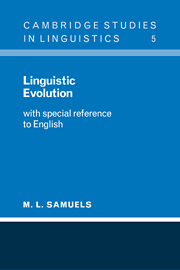Book contents
- Frontmatter
- Contents
- Preface
- Note to second impression
- Abbreviations
- 1 Introduction
- 2 Variation in the spoken chain
- 3 System: the phoneme
- 4 Grammar and lexis (I): variation
- 5 Grammar and lexis (II): systemic regulation
- 6 Diversity and contact
- 7 An assessment of the problem
- 8 Dimensions of study
- 9 Conclusions
- Bibliography
- Index of persons
- Index of subjects
- Plate section
7 - An assessment of the problem
Published online by Cambridge University Press: 05 June 2012
- Frontmatter
- Contents
- Preface
- Note to second impression
- Abbreviations
- 1 Introduction
- 2 Variation in the spoken chain
- 3 System: the phoneme
- 4 Grammar and lexis (I): variation
- 5 Grammar and lexis (II): systemic regulation
- 6 Diversity and contact
- 7 An assessment of the problem
- 8 Dimensions of study
- 9 Conclusions
- Bibliography
- Index of persons
- Index of subjects
- Plate section
Summary
Introductory
An attempt has been made in the foregoing chapters to show
(i) that there is a certain degree of predictability in the changes of intrasystemic origin that can take place: on the one hand, a continual ‘inaccuracy’ both in physiological production and in mental selection, which lowers the levels of information-content and redundancy and would, if not continuously remedied, lead to a ‘blunting’ or devaluation of the substance; and on the other, systemic regulation which automatically replaces lost information-content and, although certain limited areas of ambiguity are present in all systems, restores the overall level of redundancy;
(ii) that the precise direction taken in these normal processes of change may be wholly controlled by extralinguistic factors, or by extrasystemic factors that are ultimately of extralinguistic origin; and
(iii) that the rate of change, whether of intrasystemic or other origin, depends on the degree of exposure to extrasystemic contact.
To arrive at these conclusions, the subsystems of language have in the main been studied separately above. Such separate approaches are partly determined by the nature of the subsystems, but they are not sufficient in themselves. Amidst all the valuable specialist research on the subsystems, there is a danger of forgetting that substance – the spoken or written chain – is not a straightforward sum of its constituent parts, any more than a language system is the exact total of its subsystems.
- Type
- Chapter
- Information
- Linguistic EvolutionWith Special Reference to English, pp. 135 - 153Publisher: Cambridge University PressPrint publication year: 1972



